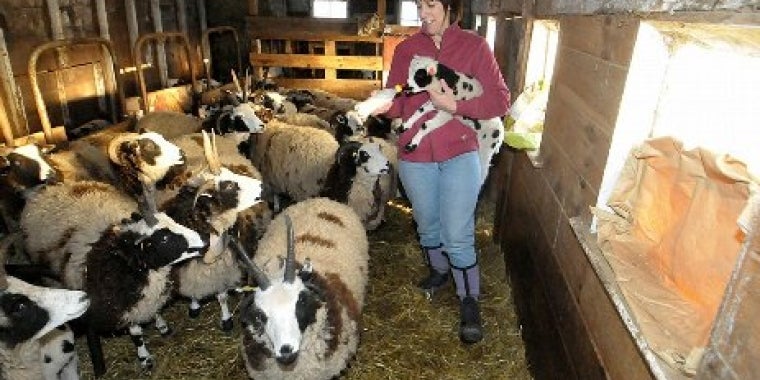
The Daily Gazette: Betting on the farm

State budget funding, estate-tax changes could help industry
Sunday, April 13, 2014
By Haley Viccaro
Gazette Reporter
Photos by Marc Schultz
State Sen. Cecilia Tkaczyk grew up on a dairy farm in New Jersey and over the past 25 years has managed her own sheep farm in Duanesburg.
Since becoming senator of the state’s 46th district, which includes parts of Albany, Schenectady and Ulster counties and all of Greene and Montgomery, Tkaczyk has been juggling her two demanding roles.
When she’s not at the Capitol, Tkaczyk might be found giving a bottle to newborn lambs, putting out grain and hay for her sheep or collecting eggs from chickens in a coop behind her home.
“I don’t have a store, but I would sell yarn a lot before I was senator, which was kind of like a side business,” said Tkaczyk, who spins her own yarn after her sheep are sheared and the wool is processed at a mill near her home. “I went to a yarn event in New York City with my friend up the street and had a booth at Vogue Knitting Live, and it sold like hot cakes. That was a lot of fun, but I just don’t have time.”
But Tkaczyk said she is glad to have the opportunity to educate her colleagues in the state Legislature about the needs of farmers in New York. She gave tours of farms in Schoharie County to a few senators before legislators passed the 2014-15 state budget on March 31.
Some of Tkaczyk’s neighbors are also sheep farmers, but a majority of farmland in Schenectady County is used to grow crops. Schenectady has nearly 200 farms, ranging from 10 acres to up to 1,000, according to the New York Farm Bureau. In 2007, Schenectady farmers sold a total of $2.6 million worth of crops.
Schenectady County Farm Bureau President Al Lansing, who owns Lansing’s Farms, a family-run vegetable farm and greenhouse business on Lishakill Road in Niskayuna, said promoting local farms is important to sustain them long-term.
He said the average age of a farmer in the state is around 60, and that it is vital for more young people to get involved in farming. But it could be a tough sell.
“There’s no weekends off and no set schedule compared to a desk job,” Lansing said. “I have to sell products in order to get income. It’s hard enough that you have to combat the weather, and then hopefully you will sell your crop.”
He said new grants included in the state budget, such as $615,000 for beginning farmers and $100,000 for recent college graduates to pay off their student loans, is a good step.
The budget also includes $1.3 million to expand marketing of local products such as apples, dairy and maple. In 2008 New York farmers sold $346 million in fruit and $468 million in vegetables, according to the state Farm Bureau.
“Promoting local products will happen through niche groups, and the money will flow through those groups for marketing efforts,” said Richard Ball, acting commissioner of the state Department of Agriculture & Markets. “For example, we will have an upstate/downstate summit for farmers to connect people in New York City with green markets. We send quite a lot of products down there from all over the state. We are looking to do a better job of that.”
Tkaczyk said providing an outlet for local farmers to sell their products is essential. She pointed to farmers’ markets and independent buyers as a big source of income for farmers. Community Supported Agriculture provides an outlet for farmers to sell directly to the consumer. Members of CSA sign up and often pay in advance for a “share” of a farm, and receive a weekly allotment of produce during the growing season.
Aside from helping farmers sell products, the budget also increases the estate tax threshold from $1 million to $5.25 million over the next three years. New York is one of 14 states in the country that has an estate tax.
Valuable relief
Thousands of farmers in the state have assets worth more than $1 million. An increase in the estate tax threshold enables farmers to pass down property and equipment to their children without a heavy tax burden.
Ball, who owns Schoharie Valley Farms, which grows fruits and vegetables and sells at farm markets and its own Carrot Barn, said that before the estate-tax threshold was raised he worried that if he died his kids would have had a challenging time taking over the farm.
“The goal is not to put a risk to a family farm,” Ball said. “When you look at land value, a farmer has hundreds of acres of land and all of a sudden they turn around and it’s worth three or four times more than what it was when they got it. This increase in the estate tax threshold puts us on par with the federal level.”
Ball is a first-generation farmer. He said the learning curve is fairly steep for new farmers and the financial curve is significantly steep. He said any incentives from the state are very positive.
“I was one of those lucky kids that really wanted to farm, but it took 20 years of work to be in a position to consider farm ownership,” Ball said. “My grandparents were farmers, but sold the farm when I was 8 years old. I got the bug for farming because I have excellent memories of it — riding on the hay wagon and being around the cows. Even as a young person, I recognized that the community respected farmers, and I always thought that I wanted to be like that one day.”
Some farmland in Saratoga County has land worth up to $8,000 an acre. The average value in the county is about $4,500 an acre, said John Arnold, president of the Saratoga County Farm Bureau. In 2010, the county had 645 farms.
“For places like Saratoga County where land is so valuable, that estate-tax threshold is important,” Arnold said. “Price depends on the quality of the acre, and a lot of it depends on where you are in Saratoga County also.”
Arnold said farmland is typically more expensive in Saratoga because of increased demand for development following computer-chip manufacturer GlobalFoundries’ move to the area in 2009.
While Schenectady County has just 200 milk cows, Saratoga County has about 8,100, according to the state Farm Bureau. The county’s farms also have 1,000 beef cattle, 600 more than in Schenectady County.
Dairy farms have a lot of electricity-intensive equipment, such as milking machines. The new budget’s accelerated phaseout of a fee on electric bills by public-utility companies, or 18-a assessment, will help to decrease farmers’ energy bills.
The phaseout is expected to save businesses and residents about $600 million over the next three years, according to the governor’s office.
“We are trying to get more people involved in farming in Saratoga County, and a phaseout of the 18-a surcharge will help our dairies a lot,” Arnold said. “If it benefits them, it benefits all of us.”
The local advantage
Tkaczyk said she would like to see more farms in the Capital Region, and said the state incentives outlined in the budget could help to attract farmers and consumers to the area.
Although it can be more expensive to buy local products than those grown and shipped from large farms far away, Tkaczyk said buying goods directly from an area farmer allows the consumer to ask questions and know more about what they are eating or, in Tkaczyk’s case, what they are wearing.
“I can say that I didn’t just make the hat but that I raised the sheep, sheared the sheep, spun the wool into the yarn and knitted the hat,” Tkaczyk said. “You can’t get much more local than that.”


